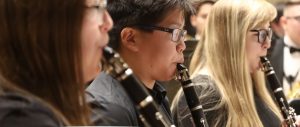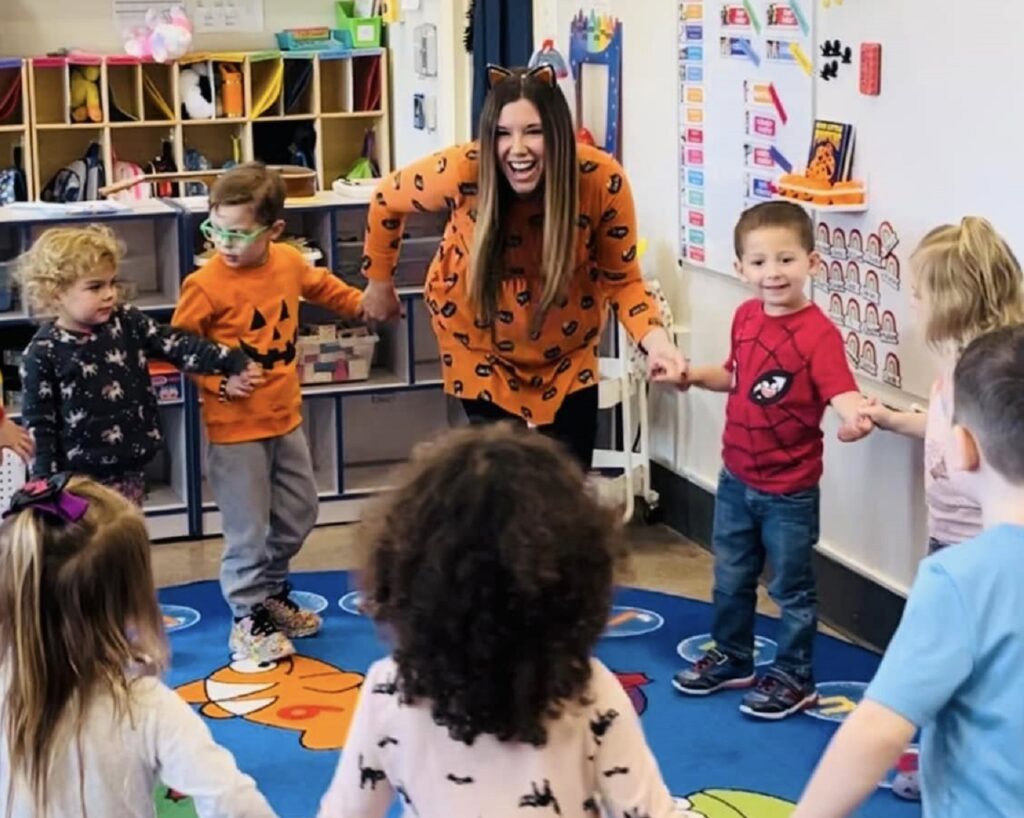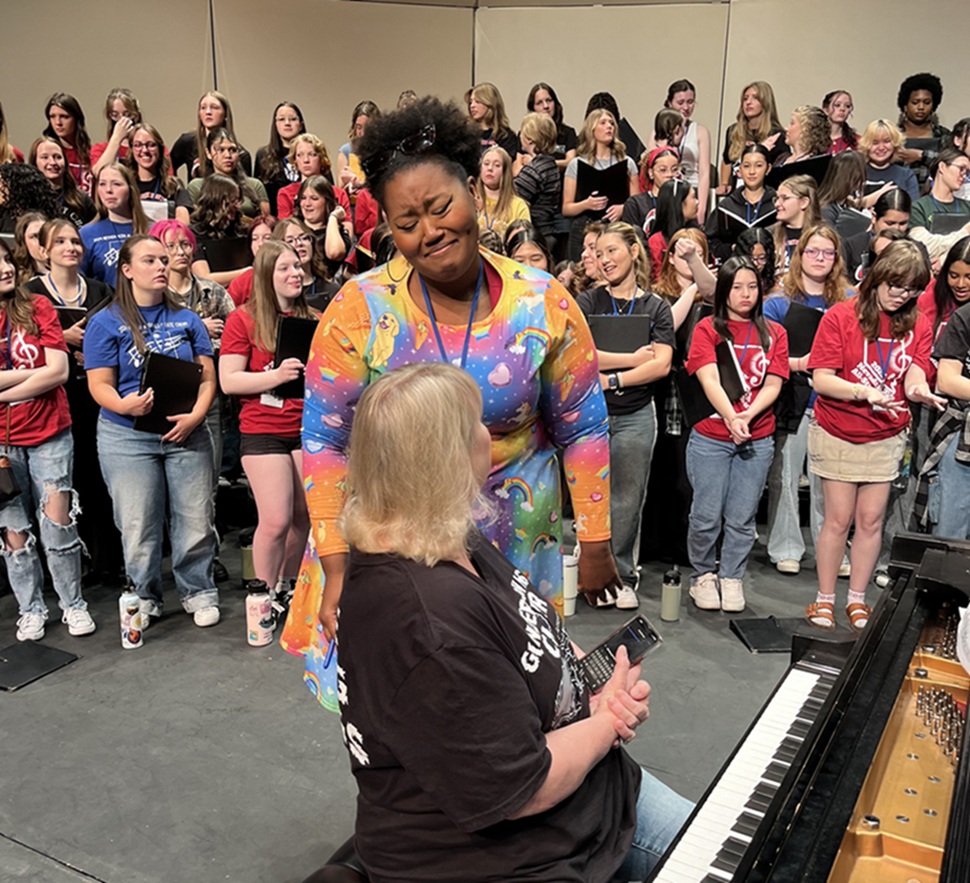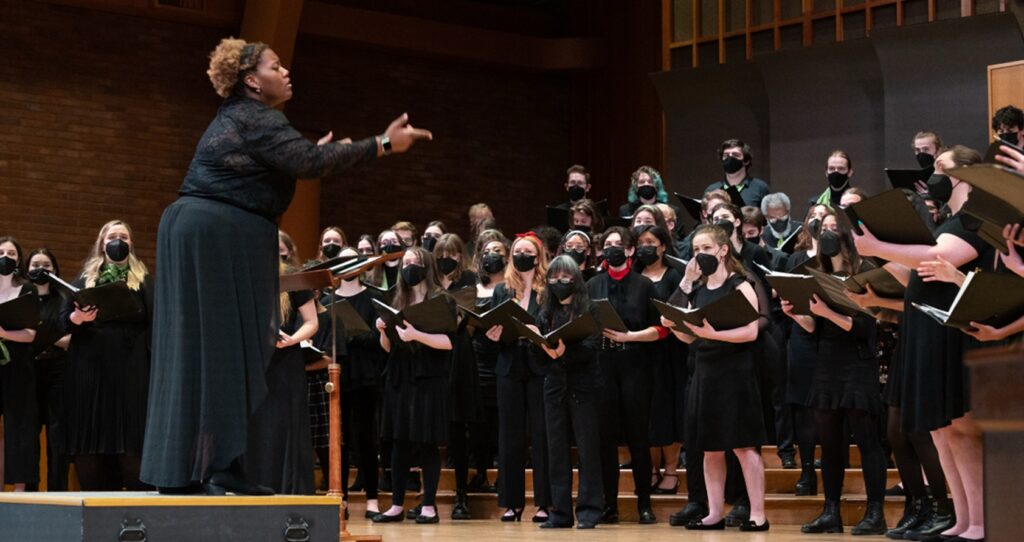Tagged Under:
A DEI Seed Takes Root at a University’s Music Library
When confronted with issues of equitable programming disparities, students at Slippery Rock University in Pennsylvania became agents of change and focused on leveraging a solution.
In the words of the iconic “Golden Girls” character Sophia Petrillo, played by Estelle Getty, “Picture it. March of 2020!”
No, this is not another article centered on strategies for teaching during a pandemic. Rather, it is the story of a seed that was planted a few semesters ago in the most adverse of conditions that is just now starting to show signs of taking root. It is the narrative of a group of Slippery Rock University (SRU) undergraduate students — mostly music majors — who, when confronted with issues of equitable programming disparities, invested their time to leverage a solution. It is a reminder that, in those moments of uncertainty when it feels as though the world has been turned upside down, some of the most important anchors that we can provide to our students come in the form of connection, self-reflection, direction and purpose.
Engaging Students with Issues of Diversity, Equity and Inclusion
When the pandemic moved our classrooms online in 2020, I decided to present the students in the SRU Symphonic Wind Ensemble with a variety of possible directions to take our new online classroom. My goals were to keep them connected while they were apart and explore topics and ideas that were relevant to them.
I first surveyed the students to discover their interests. They were presented with a variety of topics around which I would design activities, lectures and projects. Survey choices included “Voodoo and the Wind Band,” “Wind Band Music and Social Justice,” “Landmark Works of the Wind Band,” etc. However, one topic overwhelmingly received the most responses — “Diversity in Wind Band Literature.” That was our seed.
The unit began with a quote from former First Lady Michelle Obama’s speech at the Summit of the Mandela Washington Fellowship for Young African Leaders: “No country can ever truly flourish if it stifles the potential of its women and deprives itself of the contributions of half of its citizens.” The message and spirit of that speech inspired the goals for this unit:
- Goal #1: Reflect on your personal experience with wind band literature in relation to your own culture/identity/etc.
- Goal #2: Reflect on your personal experience with wind band literature in relation to the culture/identity/etc. of others.
- Goal #3: Explore music and discover resources that reflect/amplify the diversity reflected in our classroom and community.
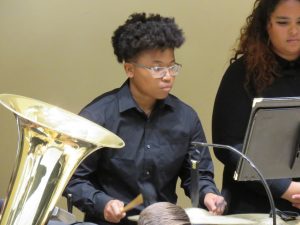 Over the course of the unit, students were introduced to foundational aspects of sociocultural identity (visible and invisible), intersectionality, and they informally mapped and reflected on their own identity. They were encouraged to describe ways in which the components of their identity are represented and/or absent in the wind band music that they have performed, studied and consumed over their lifetime. The student responses were eye-opening.
Over the course of the unit, students were introduced to foundational aspects of sociocultural identity (visible and invisible), intersectionality, and they informally mapped and reflected on their own identity. They were encouraged to describe ways in which the components of their identity are represented and/or absent in the wind band music that they have performed, studied and consumed over their lifetime. The student responses were eye-opening.
Presenting students with resources to discover repertoire written by underrepresented voices led to questions about what it means to be seen in the art that we create as a community of musicians — it was a tale of two cities. Student contributions to discussion prompts revealed an inverted bell curve, students either felt that their identity was represented with some consistency in the music they studied and performed, or they did not feel as though that was the case at all. Overwhelmingly, students expressed that they wanted to continue the conversation and, when in-person performances could resume, perform works by the composers that they had studied during this unit.
Notably, the desire to perform works from the diverse composers we studied underscored the systemic problem: Our 100-year-old music library, like many, was overrepresented with Caucasian, cis-gendered, male composers. Further, the limited budget offered through the department to acquire new music to diversify the library amounted to only $500 split among the wind ensemble, concert band and marching band. To accomplish the modest goal of ensuring that we could develop diverse and inclusive programs for each of our concerts was going to require funding.
From Students to Scholars
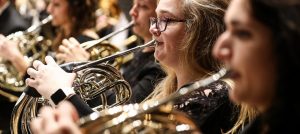 The student goal of programming concerts that more closely mirror our community has led to a multi-semester, student-driven research and grant-writing project that has resulted in successfully authoring three grants to diversify our available music library and concert programs. We have been awarded over $6,000 for new music! One award, an internal faculty-student research grant through Slippery Rock University, involves students developing a consortium to commission a composer to write a new piece for wind band that will be performed in the fall of 2023.
The student goal of programming concerts that more closely mirror our community has led to a multi-semester, student-driven research and grant-writing project that has resulted in successfully authoring three grants to diversify our available music library and concert programs. We have been awarded over $6,000 for new music! One award, an internal faculty-student research grant through Slippery Rock University, involves students developing a consortium to commission a composer to write a new piece for wind band that will be performed in the fall of 2023.
To successfully acquire those grant monies, the students in the SRU Wind Ensemble engaged in a self-study, cataloging the available demographic information of the composers within our permanent library, and analyzing the data. The goal was to identify the degree to which the available literature in the library reflected an overrepresentation of certain identities. They began by breaking themselves into teams. Each team of students used available resources (such as The Wind Repertory Project and the Institute for Composer Diversity) to research demographic and biographical data for each composer within the library.
This research was done after considering and acknowledging the limitations of the project. Some of those limitations included meaningful discussions on the following:
- How can we accurately account for invisible diversity (sexual orientation, neurodiversity, etc.)?
- How do we catalog the intersection of multiple identities?
- What aspects of diversity can we realistically research given the resources and time available?
- How can this project be scalable (timeline, workload, etc.) while still ensuring that it is meaningful?
 The students drew several conclusions. First, this project cannot accurately account for the vast multitude and complexity of identity and diversity. Second, the students acknowledged that invisible diversity is not always easily accounted for nor is it always freely expressed. With these limitations in mind, the students chose to narrow their focus on three aspects of diversity: gender/gender identity and expression, race/ethnicity, and membership in the LGBTQIA2S+ community.
The students drew several conclusions. First, this project cannot accurately account for the vast multitude and complexity of identity and diversity. Second, the students acknowledged that invisible diversity is not always easily accounted for nor is it always freely expressed. With these limitations in mind, the students chose to narrow their focus on three aspects of diversity: gender/gender identity and expression, race/ethnicity, and membership in the LGBTQIA2S+ community.
Once the raw data was cataloged, a team of student leaders analyzed the data and presented it to the members of the ensemble. The following is a summary of the findings, presented with the following caveats based on the review of available resources at the time:
- The project leaders acknowledge that identity (both visible and invisible) may not always be accurately accounted for in the available resources. Further, identity may not always be freely expressed by the composers within the library.
- Recognizing the potential limitations and inaccuracies of the available data, the students felt that this project was still worthwhile, anticipating that the result would reveal an accurate approximation of the demographics of the content of the library.
Of the 492 composers in the SRU Symphonic Wind Ensemble Library,
- 96.22% of the composers were categorized as male, 2.84% were categorized as female and 0.96% were categorized unknown.
- 90.3% of the composers were categorized as Caucasian, 2.1% as Latinx, 1.4% as Asian, 0.7% as Black/African American, with the remainder being categorized as unknown.
- 2.85% of composers within the library were categorized as being members of the LGBTQIA2s+ community.
Identifying the overrepresentation of Caucasian, male and non-LGBTQIA2S+ composers within the library, the students went so far as to compare the data from their study with the available demographic data of SRU. Contextualizing the data further reinforced the need to generate financial resources to diversify the contents of the music library.
Leveraging the Data
 To diversify the library, the students set the goal of identifying resources in the form of grants that might apply to this project. Focusing efforts first on internal grants, the following grant applications were submitted through Slippery Rock University for two separate projects. Benjamin Johnston, an undergraduate oboist and officer in the SRU Symphonic Wind Ensemble, served as co-author of each grant application. The grants were as follows:
To diversify the library, the students set the goal of identifying resources in the form of grants that might apply to this project. Focusing efforts first on internal grants, the following grant applications were submitted through Slippery Rock University for two separate projects. Benjamin Johnston, an undergraduate oboist and officer in the SRU Symphonic Wind Ensemble, served as co-author of each grant application. The grants were as follows:
- The SRU President’s Commission on Racial and Ethnic Diversity (application submitted)
- The SRU President’s Commission on Women (application submitted)
- The SRU Faculty/Student Research Grant (funded)
Through this process, two exciting projects emerged. The first two grants listed above are being leveraged to purchase existing music for our library that is written by underrepresented composers, our first project. The third grant is being used as the foundation for a consortium project to commission a living composer to write a new work for wind ensemble that will be premiered in the following year. Over the course of this project, the students will select a composer, develop consortium membership and premiere a new composition through a project that they initiated.
Moving Forward
 The two projects are now at the stage where financial resources have been generated to successfully move forward and we could not be more excited or grateful. As we transition into carrying out these projects, it is an opportune time to reflect on the impact that this has had on the students and the program. As a teacher, it has been humbling to watch students engage with issues of diversity within the profession. Over the course of the journey, students have been able to:
The two projects are now at the stage where financial resources have been generated to successfully move forward and we could not be more excited or grateful. As we transition into carrying out these projects, it is an opportune time to reflect on the impact that this has had on the students and the program. As a teacher, it has been humbling to watch students engage with issues of diversity within the profession. Over the course of the journey, students have been able to:
- Describe ways in which the aspects of their identity are represented and/or absent in the wind band music that they perform, study and consume (systemically).
- Reflect on ways in which systems (publishing, programming, etc.) overrepresent dominant identities and underrepresent non-dominant identities in the band music that they perform, study and consume.
- Identify and reflect on a variety of barriers to diverse and equitable programming.
We are still in the middle of this journey, but I hope that this article serves as a catalyst for generating more ideas on engaging students with relevant issues centered on diversity in the music that we compose, perform and consume. Most of all, I hope that it highlights how we as educators can encourage and empower students to make a difference and become










